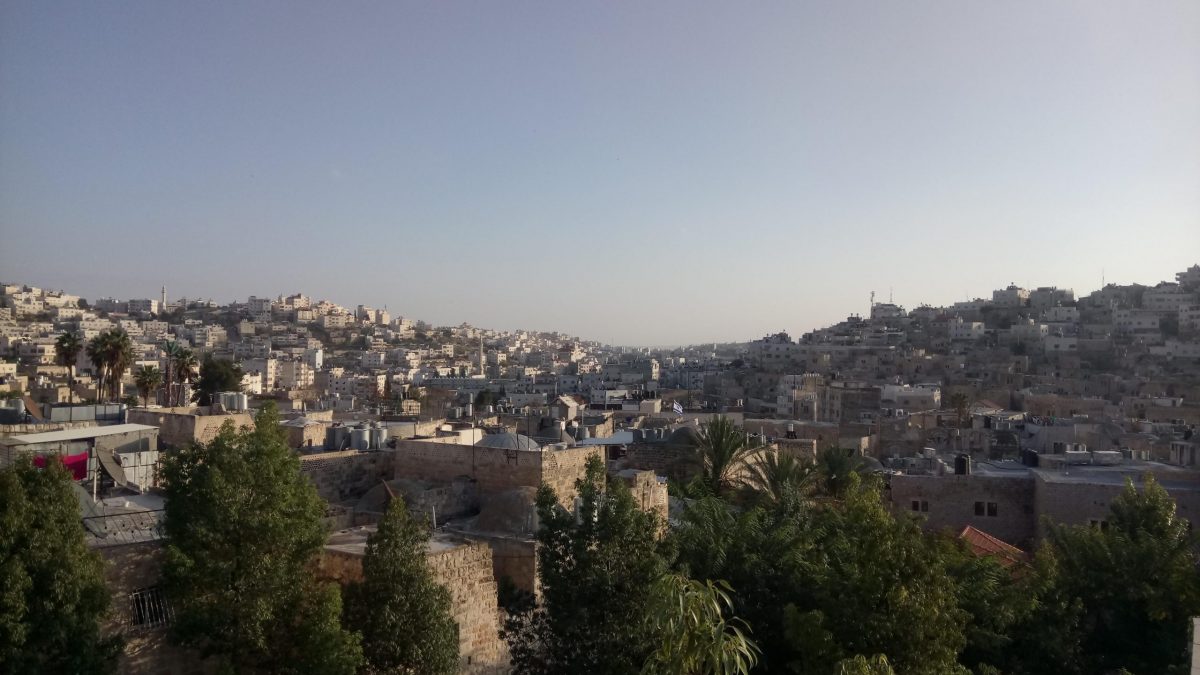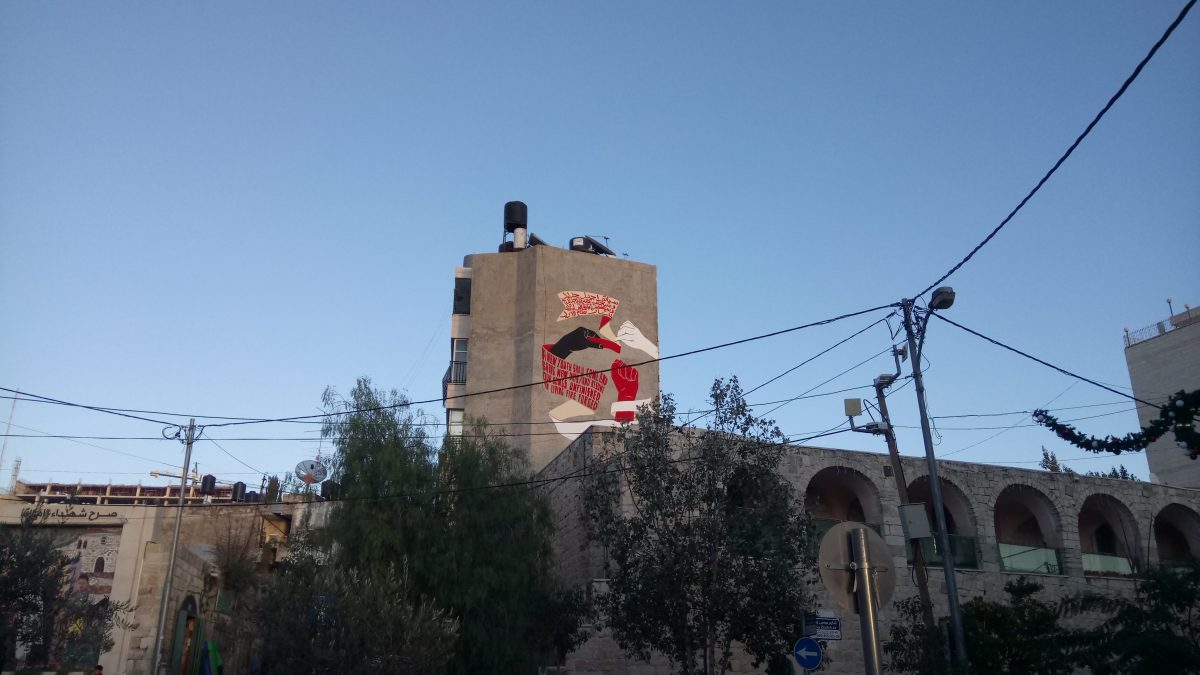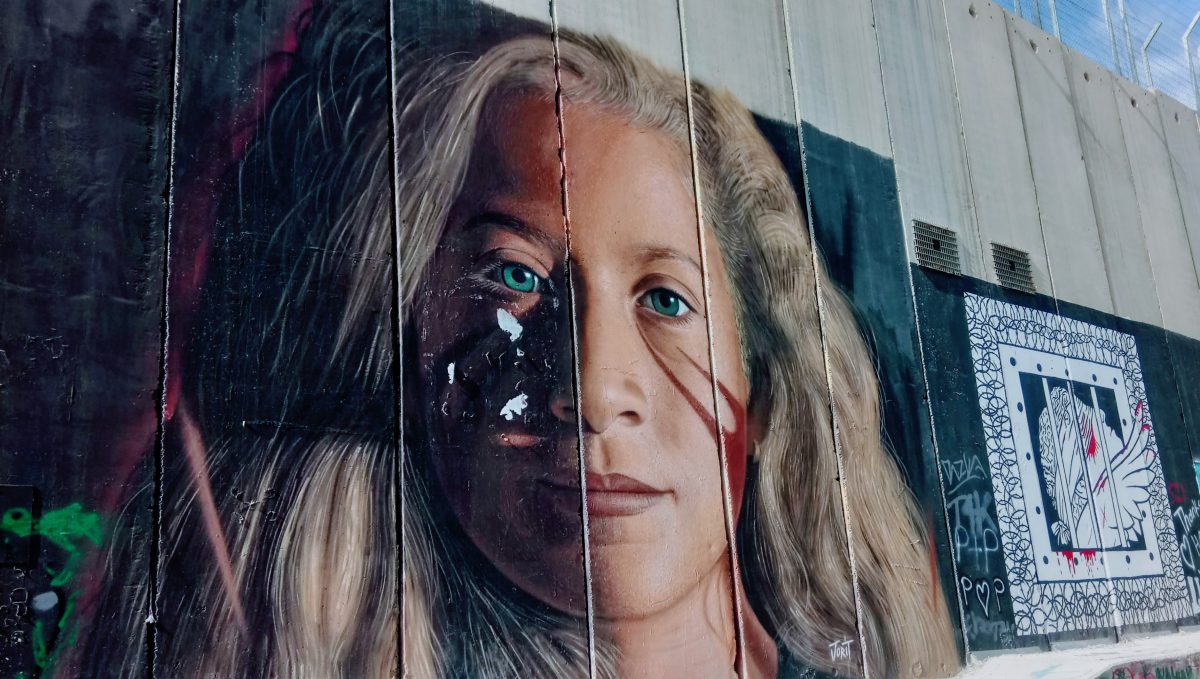Caravan Palestine: art as resistance

At the end of November, Artists’ Producer Ania travelled to Palestine for a week to represent Artsadmin at Caravan Palestine organised by IETM. Caravan Palestine is an opportunity for artists and producers to forge connections, create opportunities and engage with the work and ideas discussed in the local arts scene.
I always wanted to go to Palestine, because of a deeply felt personal support for the Palestinian cause, interest in politics and arts in the region and most recently, professional involvement in At Home in Gaza and London by Station House Opera, a digital theatre project that played simultaneously in Gaza and the UK. Interested in seeing it through my own eyes as opposed to through images in the mainstream media, I was waiting for the right opportunity. And there it came.
Before boarding the plane to Tel Aviv, I read a number of blog posts about entering Palestine. Worried about the high level of security at Israeli borders, I prepared answers for anyone that might ask me why I’m going to Ramallah (never mention ‘Palestine’ was the advice). The passengers on my plane were Orthodox Jewish families, people coming back from holiday in London, and fashionable young Londoners going to party in Tel Aviv. This unusual mix of people made me think about the strangeness and complexity of the world I was about to enter.

On our way from the airport to Ramallah, we saw Israeli settlements, went through checkpoints, heard about problems with access to clean water in Palestine, and drove next the Wall. The driver explained to us that, as a Palestinian, he could go to Ben Gurion Airport only because his car had yellow number plates from Jerusalem; someone from Ramallah with a green plated car wouldn’t be able to access Israel. I started to understand the complex system of oppression and the legalised discrimination that impacts everyday life in Palestine.
Caravan Palestine was split into two parts. The first few days we spent in Ramallah and joined the first ever Palestinian Performing Arts Showcase organised by Palestinian Performing Arts Network. During the three days, we saw performances in various venues in Ramallah and Birzeit. The Showcase included theatre, Dabkeh, storytelling, circus, music concerts, contemporary dance, and emerging performance. Discussions that surrounded the rich programme – both in an official space as part of the showcase and those that continuously carried on at meals, during walks, and at any other time – provided a useful context for the showcase and a lot of food for thought not only about making art in places of conflict but also the complexity surrounding our Western interest in it.

The debate about Palestinian-Israeli artistic collaborations, questions whether artistic partnerships can go beyond the political conflict and, if so, what rules should shape them, continued throughout the week. Similarly, the Boycott, Divestment and Sanctions Movement (BDS) divided the group and led to conversations analysing how presenting our own work in Israel could be a chance to criticise the Israeli government and its oppressive politics. I agree with BDS and I know Palestinians see it as an expression of our support for them. In the same way, I think that any artistic collaboration between artists from the two countries can only be initiated by Palestinians. These projects would always exist within the context of extreme inequality and imbalance of power where Palestine is unquestionably the oppressed side. That’s why it is so important to give Palestinians voice on all these issues and prioritise their views on them.
Most of the shows in the Showcase delved into Palestinian history and told stories of how political decisions taken without Palestinians impacted their lives. The occupation was present in pretty much all of them; art here is clearly a medium for the collective memory, a tool to preserve the culture that is being muted. Even Dabkeh as a traditional Palestinian dance is such a strong expression of Palestinian identity that it becomes a significant voice against the occupation. As in any country’s case, it’s incredibly difficult to detach the art that is being made in Palestine from its historical traumas and contemporary issues. I’m very curious to know which performances from the Showcase will be shown by international programmers. The desire to see work that is not focused on the occupation – which we expressed so frequently during these hectic three days in Ramallah – often stands in opposition to our voyeuristic approach to work and politics from the Middle East. So much of the work from Palestine which has made it to festivals in the West is there precisely because it deals with war and conflict, the lens through which we look into the region.

The second part of our visit started with a long trip from Ramallah to Bethlehem. It took us through beautiful hilly landscapes and few small towns. We passed remote Bedouin villages and several Israeli settlements. A lot of the land that we went through is Area C – an area that spreads across 60% of the West Bank territory, surrounds a lot of Palestinian towns and villages but is controlled by Israel (e.g. planning, building, access to natural resources are all under Israeli control).
When in Bethlehem, we visited Walled Off Hotel that was set up by Banksy, right next to the Wall, where rooms cost up to 1000 USD per night. The commercial activity that is flourishing in this area of Bethlehem, with shops selling made in China Wall-themed souvenirs and Instagram-friendly graffiti, left me with bitter feelings about how capitalism profits from “activist” tourism and generally travel to places of conflict. In the hotel, I saw the exhibition of work by contemporary Palestinian artists and the installation on the history of the occupation that was really well put together, but I also wondered how much the hotel gives back to the local community.

Our visit to Hebron the next day was quite a contrast to this fancy, designer hotel. Hebron is a beautiful town in the West Bank where Israelis settled in the middle of the city among houses inhabited by Palestinian communities, forcing most of them out. This has happened despite Hebron being under the Palestinian authority. Israeli flags mark buildings and spaces that no longer belong to Palestinians. Watchtowers surround H2 – part of the old city that is now under Israeli control – and there are checkpoints in the middle of the town, including one at the entrance to the Ibrahimi Mosque. Allegedly, each Israeli deciding to move to Hebron gets three soldiers to protect them and the military presence in the town is felt everywhere. We passed through a market where most shops have been closed in recent years after tourists stopped coming. A net was put on the top of the market alleys to protect the shopkeepers and buyers from the rubbish that Israelis throw from the windows of the flats above. This was perhaps the most painful experience that I encountered in Palestine – a pure image of human hatred and humiliation.
Given all the discrimination that Palestinians have to withstand in this West Bank town, their resistance is incredible. The Hebron Rehabilitation Committee renovate buildings and public areas, and their main objective is to bring back Palestinians who had left when Israel introduced military control over large parts of the city. Renovation and restoration have become tools of resistance to the Israeli occupation similarly to the performances that were part of the Showcase in Ramallah. The Palestinians I met in the West Bank refuse to give up and lose hope that the occupation will end one day. They organise themselves, keep working and try to change the reality in Palestine by various grassroots initiatives.
Still, the most powerful part of my visit was being immersed in the everyday life of the country. There is so much more to Palestine than refugee camps and checkpoints: Palestinian hospitality, bars in Ramallah, great contemporary music (see documentary Palestine Underground released recently by Boiler Room), markets in Bethlehem, the best knafeh, falafel and hummus one can imagine, picturesque landscapes that are perfect for walking (check out Palestinian Walks by Raja Shehadeh), fresh pomegranate juice, arty and cool Beit Sahour, beautiful architecture of Hebron and, of course, a thriving arts scene. And then, the will and activism of the Palestinians who work in the arts, against all the challenges, is extraordinary. That is why us – artists, promoters and producers – should lead the way in supporting Palestine by visiting, bringing Palestinian artists to Europe, collaborating with them and giving them voice.
